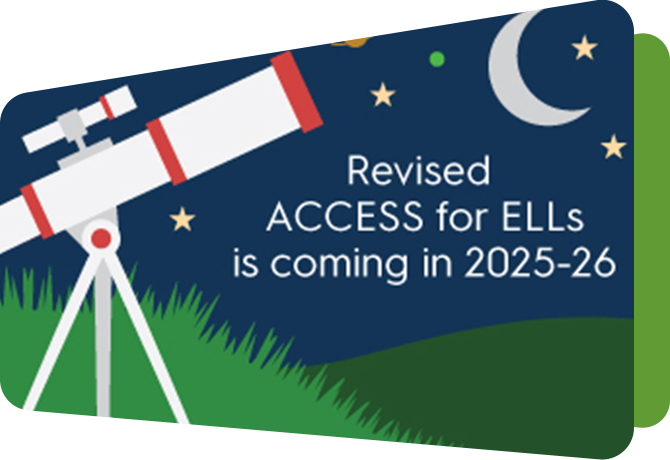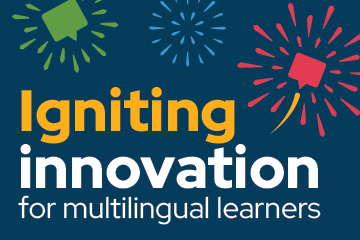Resources/Recursos
Featured Resources



All resources/Todos los recursos
Filter resources by:
Resources/Recursos
Universal Design for Learning Example Ideas Chart
This handout provides ideas for applying the Universal Design for Learning (UDL) framework in your classroom. It offers strategies to help all students, including multilingual learners with disabilities, participate in meaningful and challenging learning.
For more context around this resource, please visit the Supporting Multilingual Learners with Disabilities page.
Resource Details View Download NowReleased October 2025
Anchor Chart
This anchor chart highlights helpful words and math terms that students can use when explaining how to solve an equation in English. It includes sequence words, cardinal numbers, and math terms.
For additional context, including additional resources and videos, please visit the Standards in Action page.
Resource Details View Download NowReleased September 2025
A Framework for Understanding English Learners With Disabilities: Triple the Work
This ALTELLA Research Brief explains the Language and Disability Needs Framework. The brief focuses on considerations of students’ language-related and disability-related needs and their implications for instruction and assessment.
Resource DetailsReleased September 2025
Case Examples of English Learners With Significant Cognitive Disabilities
This ALTELLA Research Brief provides case examples of multilingual learners who have significant cognitive disabilities. The brief has five student examples: Sabeen (grade 1), Chung (grade 2), Chue (grade 4), Isabel (grade 6) and Luis (grade 10).
Resource DetailsReleased September 2025
Plan Curriculum, Instruction and Classroom Assessment With the WIDA Language Charts
This WIDA Snapshot provides guidance on how to use the WIDA Language Charts to collaborate and plan instruction.
Resource DetailsReleased August 2025
Introducing WIDA Screener for Kindergarten
This WIDA Screener for Kindergarten eSummit session recording provides an in depth look at the test.
Resource DetailsReleased October 2024
WIDA MODEL and the CEFR
WIDA conducted a research study that linked WIDA MODEL Online scale scores to the Common European Framework of Reference (CEFR). This video discusses the research study, the findings, and the Understanding WIDA MODEL Online Scale Scores in Terms of CEFR Levels tool.
Resource DetailsReleased January 2024
Putting It All Together: Next Steps for Using the 2020 Edition
In this webinar, the WIDA standards development team discusses and models the tools, provided in the 2020 Edition, for initiating critical conversations with school leaders and colleagues.
Resource DetailsReleased March 2021
Curricular Considerations: Introduction to Collaborating Around the 2020 Edition
The WIDA ELD Standards Framework, 2020 Edition brings new practical ways for all educators working with multilingual learners to conceptualize the development of content and language together through asset-based, equitable, and rigorous approaches in curricular design. This session will encourage participants to think about what collaboration looks like in these contexts.
Resource DetailsReleased February 2021
Introduction to the Updated Key Language Uses
One of the components of the WIDA ELD Standards Framework is the Key Language Uses (KLUs). The KLUs summarize the most prominent language uses across disciplines, helping educators organize and prioritize curriculum and instruction. Learn about the updated KLUs – Inform, Narrate, Explain and Argue.
Resource DetailsReleased February 2021
Can Do Descriptors Student Name Charts, Kindergarten
This chart allows educators to track students by their level of English language proficiency.
Resource Details View Download NowReleased June 2020
Can Do Descriptors Student Name Charts, Grade 1
This chart allows educators to track students by their level of English language proficiency.
Resource Details View Download NowReleased April 2020
Can Do Descriptors Student Name Charts, Grades 2-3
This chart allows educators to track students by their level of English language proficiency.
Resource Details View Download NowReleased April 2020
Can Do Descriptors Student Name Charts, Grades 4-5
This chart allows educators to track students by their level of English language proficiency.
Resource Details View Download NowReleased April 2020
Can Do Descriptors Student Name Charts, Grades 6-8
This chart allows educators to track students by their level of English language proficiency.
Resource Details View Download NowReleased April 2020
Can Do Descriptors Student Name Charts, Grades 9-12
This chart allows educators to track students by their level of English language proficiency.
Resource Details View Download NowReleased April 2020
Can Do Descriptors Name Charts, Grades K-12
This chart allows educators to track students by their level of English language proficiency.
Resource Details View Download NowReleased January 2016
Can Do Descriptors, Original Edition, Student Name Charts, Grades K-12
This chart allows educators to track students by their level of English language proficiency.
Resource Details View Download NowReleased April 2013




